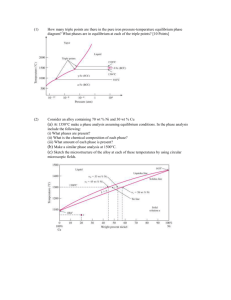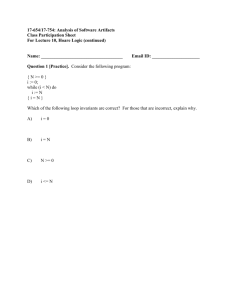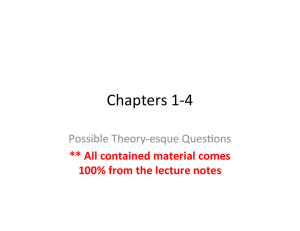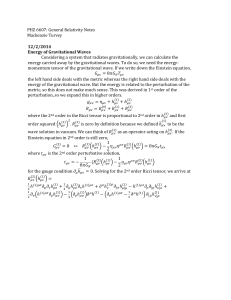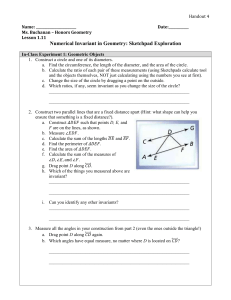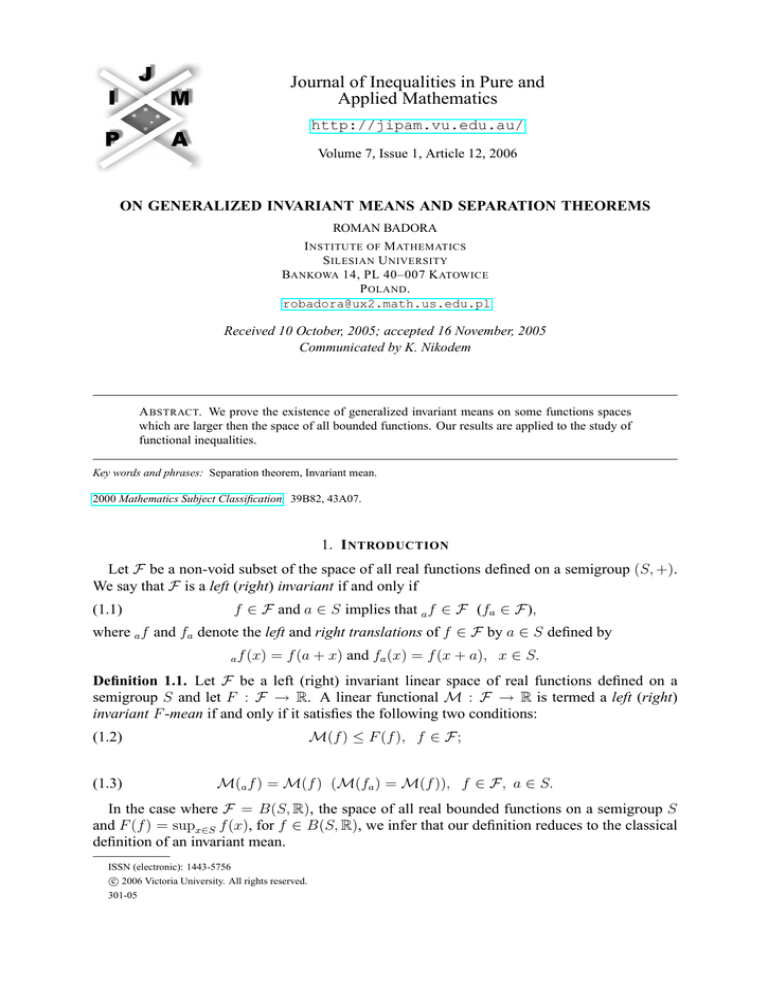
Journal of Inequalities in Pure and
Applied Mathematics
http://jipam.vu.edu.au/
Volume 7, Issue 1, Article 12, 2006
ON GENERALIZED INVARIANT MEANS AND SEPARATION THEOREMS
ROMAN BADORA
I NSTITUTE OF M ATHEMATICS
S ILESIAN U NIVERSITY
BANKOWA 14, PL 40–007 K ATOWICE
P OLAND .
robadora@ux2.math.us.edu.pl
Received 10 October, 2005; accepted 16 November, 2005
Communicated by K. Nikodem
A BSTRACT. We prove the existence of generalized invariant means on some functions spaces
which are larger then the space of all bounded functions. Our results are applied to the study of
functional inequalities.
Key words and phrases: Separation theorem, Invariant mean.
2000 Mathematics Subject Classification. 39B82, 43A07.
1. I NTRODUCTION
Let F be a non-void subset of the space of all real functions defined on a semigroup (S, +).
We say that F is a left (right) invariant if and only if
(1.1)
f ∈ F and a ∈ S implies that a f ∈ F (fa ∈ F),
where a f and fa denote the left and right translations of f ∈ F by a ∈ S defined by
a f (x)
= f (a + x) and fa (x) = f (x + a), x ∈ S.
Definition 1.1. Let F be a left (right) invariant linear space of real functions defined on a
semigroup S and let F : F → R. A linear functional M : F → R is termed a left (right)
invariant F -mean if and only if it satisfies the following two conditions:
(1.2)
M(f ) ≤ F (f ), f ∈ F;
(1.3)
M(a f ) = M(f ) (M(fa ) = M(f )), f ∈ F, a ∈ S.
In the case where F = B(S, R), the space of all real bounded functions on a semigroup S
and F (f ) = supx∈S f (x), for f ∈ B(S, R), we infer that our definition reduces to the classical
definition of an invariant mean.
ISSN (electronic): 1443-5756
c 2006 Victoria University. All rights reserved.
301-05
2
ROMAN BADORA
In argument with the traditional terminology, if there exists at least one left (right) invariant
mean on the space B(S, R) then the underlying semigroup S is said to be left (right) amenable.
For the theory of amenability of semigroups and groups see e.g. Greenleaf [7] and Hewitt, Ross
[8]. Here we only stress that every Abelian semigroup is (two-sided) amenable.
The concept of invariant means in connection with functional inequalities was invented by L.
Székelyhidi (see [12]). In the present paper we are going to extend the concept of an invariant
mean to some functions spaces which are essentially larger then the space B(S, R). Next, we
present applications of these results to the study of functional inequalities.
2. G ENERALIZED I NVARIANT M EANS
Let us start with the following existence theorem.
Theorem 2.1. Let (S, +) be a left (right) amenable semigroup and let F be a left (right) invariant linear space of real functions defined on S. Assume that functionals Φ, F : F → R satisfy
the following conditions:
(2.1)
Φ(f + g) ≤ Φ(f ) + Φ(g), f, g ∈ F;
(2.2)
Φ(αf ) = αΦ(f ), f ∈ F, α > 0;
(2.3)
Φ(f ) ≤ F (f ), f ∈ F
and
(2.4)
Φ(a f ) ≤ F (f ) (Φ(fa ) ≤ F (f )) , f ∈ F, a ∈ S.
Then there exists a left (right) invariant F -mean on the space F.
Proof. We shall restrict ourselves to the proof of the "left - hand side version" of this theorem.
To start with, note that by condition (2.1)
0 ≤ Φ(0S ),
(2.5)
where 0S denotes the function equal zero on the whole semigroup S. The Hahn - Banach
theorem, for the space X = F and the subspace X0 degenerated to zero, implies that there
exists a linear operator L : F → R such that
L(f ) ≤ Φ(f ), f ∈ F.
Then, by (2.3), we get
L(f ) ≤ Φ(f ) ≤ F (f ), f ∈ F.
(2.6)
Let f ∈ F be fixed. Condition (2.4) implies
L(x f ) ≤ Φ(x f ) ≤ F (f ), x ∈ S.
Using the linearity of L we have
(2.7)
−F (−f ) ≤ L(x f ) ≤ F (f ), x ∈ S
which means that the function
S 3 x −→ L(x f ) ∈ R
belongs to the space B(S, R).
Let M be a left invariant mean on B(S, R) which exists by our assumption. We define the
map M : F → R by the formula:
M(f ) = Mx (L(x f )), f ∈ F,
J. Inequal. Pure and Appl. Math., 7(1) Art. 12, 2006
http://jipam.vu.edu.au/
O N G ENERALIZED I NVARIANT M EANS AND S EPARATION T HEOREMS
3
where the subscript x next to M indicates that the mean M is applied to a function of the
variable x.
From the linearity of L and M we obtain that M is a linear functional. Moreover, condition
(2.7) implies
M(f ) = Mx (L(x f )) ≤ sup L(x f ) ≤ F (f ),
x∈S
for f ∈ F.
To prove the left invariance of M we observe that
y (x f )
=x+y f, f ∈ F, x, y ∈ S.
Indeed, for every z ∈ S we get
y (x f )(z)
=x f (y + z) = f (x + y + z) =x+y f (z), x, y ∈ S,
which means that our identity holds.
This fact combined with the left invariance of M yields
M(a f ) = Mx (L(x (a f ))) = Mx (L(a+x f )) = Mx (L(x f )) = M(f ),
for all f ∈ F and a ∈ S. Thus, the map M has all the desired properties for a left invariant
F -mean and the proof is completed.
Remark 2.2. If M is a left (right) invariant F -mean on the space F, then the linearity of M
jointly with condition (1.2) yields
(2.8)
−F (−f ) ≤ M(f ) ≤ F (f ), f ∈ F.
Remark 2.3. If the space F contains the space CS of all constant functions on S, then in the
proof of Theorem 2.1 we can start with the space X0 = CS and with the functional L0 : CS → R
defined by L0 (cS ) = cΦ(1S ), for c ∈ R and we obtain the existence of the F -mean M such
that
(2.9)
M(cS ) = cΦ(1S ), c ∈ R.
Now, we will give examples of situations in which all assumptions of Theorem 2.1 are satisfied.
Definition 2.1. A non-empty family I of subsets of a semigroup S will be called a proper set
ideal if:
S 6∈ I;
A, B ∈ I implies A ∪ B ∈ I;
A ∈ J and B ⊂ A imply B ∈ I.
Moreover, if the set a A = {x ∈ S : a + x ∈ A} belongs to the family I whenever A ∈ I
and a ∈ S, then the set ideal I is said to be proper left quasi-invariant (in short: p.l.q.i.).
Analogously, the set ideal I is said to be proper right quasi-invariant (in short: p.r.q.i.) if the
set Aa = {x ∈ S : x + a ∈ A} belongs to the family I whenever A ∈ I and a ∈ S. In the case
where the set ideal satisfies both these conditions we shall call it proper quasi-invariant (p.q.i.).
The sets belonging to the ideal are intuitively regarded as small sets. For example, if S is
a second category subsemigroup of a topological group G then the family of all first category
subsets of S is a p.q.i. ideal. If G is a locally compact topological group equipped with the
left or right Haar measure µ and if S is a subsemigroup of G with positive measure µ then the
family of all subsets of S which have zero measure µ is a p.q.i. ideal. Also, if S is a normed
space (S 6= {0}) then the family of all bounded subsets of S is p.q.i. ideal (see also Gajda [5]
and Kuczma [9]).
J. Inequal. Pure and Appl. Math., 7(1) Art. 12, 2006
http://jipam.vu.edu.au/
4
ROMAN BADORA
Let I be a set ideal of subsets of a semigroup S. For a real function f on S we define If to
be the family of all sets A ∈ I such that f is bounded on the complement of A. A real function
f on S is called I-essentially bounded if and only if the family If is non-empty. The space of
all I-essentially bounded functions on S will be denoted by B I (S, R).
It is obvious that, in general, the space B I (S, R) is essentially larger then the space B(S, R).
For every element f of the space B I (S, R) the real numbers
I − ess inf f (x) = sup inf f (x),
x∈S
A∈If x∈S\A
I − ess sup f (x) = inf sup f (x)
A∈If x∈S\A
x∈S
are correctly defined and are referred to as the I-essential infimum and the I-essential supremum of the function f , respectively.
Now, we define a map F I : B I (S, R) → R by the following formula:
F I (f ) = I − ess sup f (x), f ∈ B I (S, R).
x∈S
If I is a p.l.q.i. (p.r.q.i.) ideal of a subset of S, then F = B I (S, R) is a left right invariant
linear space and functions Φ = F I , F = F I satisfy conditions (2.1), (2.2), (2.3) and (2.4).
So, as a consequence of Theorem 2.1 we obtain the following result which was proved using
Silverman’s extension theorem by Gajda in [5] (see also [1]).
Corollary 2.4. If (S, +) is a left (right) amenable semigroup and I is a p.l.q.i. (p.r.q.i.) ideal
of subsets of S, then there exists a real linear functional M I on the space B I (S, R) such that
I − ess inf f (x) ≤ M I (f ) ≤ I − ess sup f (x)
x∈S
x∈S
and
M I (a f ) = M I (f ) (M I (fa ) = M I (f )),
for all f ∈ B I (S, R) and all a ∈ S.
The next example is a generalization of Gajda’s example (see [6]). Here we assume that
p : S × S → [0, +∞) is a given function fulfilling the following condition:
( n
)
( n
)
!
X
X
(2.10)
inf
p(xi , ai + s) : s ∈ S = 0
inf
p(xi , s + ai ) : s ∈ S = 0 ,
i=1
i=1
for all a1 , a2 , . . . , an ∈ S, x1 , x2 , . . . , xn ∈ S and n ∈ N. We say that the function f : S → R
is p-bounded if there exist constants cf , Cf ∈ R, kf , Kf ≥ 0, n ∈ N and a1 , a2 , . . . , an ∈ S,
x1 , x2 , . . . , xn ∈ S such that
n
n
X
X
c f − kf
p(xi , ai + s) ≤ f (s) ≤ Cf + Kf
p(xi , ai + s)
(cf − kf
i=1
i=1
n
X
n
X
p(xi , s + ai ) ≤ f (s) ≤ Cf + Kf
i=1
p(xi , s + ai )),
i=1
for all s ∈ S. The space of all p-bounded functions will be denoted by B p (S, R). This space is
a left (right) invariant linear space.
Let f ∈ B p (S, R) be fixed. Then, using the fact that
(
)
n
n
X
X
inf Kf
p(xi , ai + s) + kf
p(xi , ai + s) : s ∈ S = 0
i=1
J. Inequal. Pure and Appl. Math., 7(1) Art. 12, 2006
i=1
http://jipam.vu.edu.au/
O N G ENERALIZED I NVARIANT M EANS AND S EPARATION T HEOREMS
(
inf
Kf
n
X
p(xi , s + ai ) + kf
i=1
n
X
5
)
p(xi , s + ai ) : s ∈ S
!
=0
i=1
we get cf − Cf ≤ 0. So,
cf ≤ Cf
which means that the set Cf of all Cf ∈ R such that there exist Kf ≥ 0, n ∈ N, a1 , a2 , . . . , an ∈
S and x1 , x2 , . . . , xn ∈ S fulfilling
!
n
n
X
X
f (s) ≤ Cf + Kf
p(xi , ai + s)
f (s) ≤ Cf + Kf
p(xi , s + ai ) , s ∈ S
i=1
i=1
p
is bounded from below. Therefore, we can define the map F : B p (S, R) → R by the following
formula:
F p (f ) = inf Cf , f ∈ B p (S, R).
(2.11)
It is easy to show that functions Φ = F p and F = F p satisfy conditions (2.1), (2.2), (2.3) and
(2.4). In this case Theorem 2.1 reduces to the following.
Corollary 2.5. If p : S ×S → [0, +∞) satisfies condition (2.10) and S is a left (right) amenable
semigroup, then there exists a real linear functional M p on the space B p (S, R) such that
M p (f ) ≤ F p (f ), f ∈ B p (S, R);
(2.12)
and
(2.13)
M p (a f ) = M p (f ) (M p (fa ) = M p (f )) , f ∈ B p (S, R), a ∈ S.
3. S EPARATION T HEOREMS
We shall formulate all results of this section in the case corresponding to the left invariant
mean only. It will be quite obvious how to rephrase the results so as to obtain its right - handed
versions. The proofs of these alternative theorems require only minor changes and, therefore,
will be omitted.
Theorem 3.1. Let S be a left amenable semigroup and let f, g : S → R. Then there exists an
additive function a : S → R such that
f (x) ≤ a(x) ≤ g(x), x ∈ S
(3.1)
if and only if there exists a left invariant linear space F of real functions on S which contains
the space of all constant functions on S, the map F : F → R fulfilling
(3.2)
F (f + g) ≤ F (f ) + F (g), f, g ∈ F;
(3.3)
F (αf ) = αF (f ), f ∈ F, α > 0;
(3.4)
F (a f ) ≤ F (f ), f ∈ F, a ∈ S
and the following condition:
(3.5)
F (f ) ≤ 0, for f ≤ 0S , f ∈ F and F (1S ) > 0,
functions ζ, η : S → [0, +∞), such that ζ, η ∈ F and F (ζ) = F (η) = 0 and a function
ϕ : S → R such that, for every x ∈ S, the map:
(3.6)
S 3 y −→ ϕ(x + y) − ϕ(y) ∈ R
J. Inequal. Pure and Appl. Math., 7(1) Art. 12, 2006
http://jipam.vu.edu.au/
6
ROMAN BADORA
belongs to the space F and
(3.7)
f (x) − ζ(y) ≤ ϕ(x + y) − ϕ(y) ≤ g(x) + η(y), x, y ∈ S.
Proof. Let f, g : S → R. Assume that there exists an additive function a : S → R satisfying
(3.1). Then the space F = CS = {cS : c ∈ R} is a left invariant linear space and the map
F : F → R defined by
F (cS ) = c, c ∈ R
fulfills (3.2), (3.3), (3.4) and (3.5). Moreover, taking ϕ = a, the additivity of a implies that the
function (3.6) is constant (equal a(x), for x ∈ S) - belongs to F and from condition (3.1) we
infer that ϕ satisfies (3.7) with ζ, η = 0S .
Now, we assume that F is a left invariant linear space of real functions on S containing the
space of all constant functions on S, the map F : F → R satisfies (3.2), (3.3), (3.4) and (3.5),
functions ζ, η : S → [0, +∞) belong to the space F, F (ζ) = F (η) = 0 and that there exists a
function ϕ : S → R fulfilling (3.6) and (3.7).
Let M be a left invariant F -mean on the space F whose existence results from Theorem 2.1
for Φ = F . By Remark 2.3 we can assume that
(3.8)
M(cS ) = cF (1S ), c ∈ R.
Moreover, condition (3.5) implies the monotonicity of M:
(3.9)
f, g ∈ F, f ≤ g =⇒ M(f ) ≤ M(g).
Indeed, if f, g ∈ F satisfy f ≤ g, then using conditions (1.2) and (3.5) we get
M(f ) − M(g) = M(f − g) ≤ F (f − g) ≤ 0.
Next, by our assumptions −ζ, −η ≤ 0S and F (ζ) = F (η) = 0. Applying (3.5) and (2.8) we
have
0 ≤ −F (−ζ) ≤ M(ζ) ≤ F (ζ) = 0
and
0 ≤ −F (−η) ≤ M(η) ≤ F (η) = 0.
Hence,
M(ζ) = M(η) = 0.
(3.10)
Now, we put α(x) = My (ϕ(x + y) − ϕ(y)), for x ∈ S. Let x, y ∈ S. Then using the linearity
and left invariance of M we get
α(x + y) = Mz (ϕ(x + y + z) − ϕ(z))
= Mz (ϕ(x + y + z) − ϕ(y + z) + ϕ(y + z) − ϕ(z))
= Mz (ϕ(x + y + z) − ϕ(y + z)) + Mz (ϕ(y + z) − ϕ(z))
= Mz (ϕ(x + z) − ϕ(z)) + Mz (ϕ(y + z) − ϕ(z))
= α(x) + α(y),
so that α is additive. Moreover, by the definition of α, conditions (3.7), (3.9), (3.10) and (3.8)
imply
f (x)F (1S ) = My (f (x)) = My (f (x)) − My (ζ(y)) = My (f (x) − ζ(y))
≤ My (ϕ(x + y) − ϕ(y)) = α(x)
≤ My (g(x) + η(y)) = My (g(x)) + My (η(y)) = My (g(x))
= g(x)F (1S ),
J. Inequal. Pure and Appl. Math., 7(1) Art. 12, 2006
http://jipam.vu.edu.au/
O N G ENERALIZED I NVARIANT M EANS AND S EPARATION T HEOREMS
7
for all x ∈ S. Consequently, the map a = F (1S )−1 α is an additive function fulfilling (3.1),
which ends the proof.
Applications of Corollary 2.4 can be found in Gajda’s paper [5] and in [3]. Applying Corollary 2.5 we have the following result on the separation of two functions by an additive map (see
also Páles [11], Nikodem, Páles, Wa̧sowicz [10] and [4], [3]).
Theorem 3.2. Let S be a left amenable semigroup with the neutral element, p : S × S →
[0, +∞) satisfying condition (2.10) and let f, g : S → R. Then there exists an additive function
a : S → R fulfilling (3.1) if and only if there exists a function ϕ : S → R such that
(3.11)
f (x) − p(x, y) ≤ ϕ(x + y) − ϕ(y) ≤ g(x) + p(x, y), x, y ∈ S.
Proof. If a is an additive function fulfilling (3.1), then ϕ = a satisfies (3.11).
Assume that ϕ : S → R satisfies (3.11). Then, for every x ∈ S, the map
S 3 y −→ ϕ(x + y) − ϕ(y) ∈ R
belongs to the space B p (S, R) and, as in the proof of Theorem 3.1, a : S → R defined by the
formula:
a(x) = My (ϕ(x + y) − ϕ(y)), x ∈ S
is an additive function. Moreover, by the definition of F p we have
f (x) = −(−f (x)) ≤ −F p (−(ϕ(x + y) − ϕ(y)))
≤ −My (−(ϕ(x + y) − ϕ(y))) = My (ϕ(x + y) − ϕ(y))
= a(x) ≤ F p (ϕ(x + y) − ϕ(y)) ≤ g(x),
for all x ∈ S and the proof of Theorem 3.2 is finished.
R EFERENCES
[1] R. BADORA, On an invariant mean for J -essentially bounded functions, Facta Universitatis (Niš),
Ser. Math. Inform., 6 (1991), 95–106.
[2] R. BADORA, On some generalized invariant means and almost approximately additive functions,
Publ. Math. Debrecen, 44(1-2) (1994), 123–135.
[3] R. BADORA, Invariant means, set ideals and separation theorems, J. Inequal. Pure Appl. Math.,
6(1) (2005), Art. 18. [ONLINE: http://jipam.vu.edu.au/article.php?sid=487].
[4] R. BADORA, R. GER AND Zs. PÁLES, Additive selections and the stability of the Cauchy functional equation, ANZIAM J., 44 (2003), 323–337.
[5] Z. GAJDA, Invariant Means and Representations of Semigroups in the Theory of Functional Equations, Prace Naukowe Uniwersytetu Śla̧skiego, Silesian University Press, Katowice, Vol. 1273,
1992.
[6] Z. GAJDA, Generalized invariant means and their applications to the stability of homomorphisms,
(manuscript).
[7] F.P. GREENLEAF, Invariant Mean on Topological Groups and their Applications, Van Nostrand
Mathematical Studies, vol.16, New York - Toronto - London - Melbourne, 1969.
[8] E. HEWITT AND K.A. ROSS, Abstract Harmonic Analysis, vol. I, Springer Verlag, Berlin - Göttingen - Heidelberg, 1963.
[9] M. KUCZMA, An Introduction to the Theory of Functional Equations and Inequalities, Państwowe
Wydawnictwo Naukowe and Silesian University Press, Warszawa - Kraków - Katowice, 1985.
J. Inequal. Pure and Appl. Math., 7(1) Art. 12, 2006
http://jipam.vu.edu.au/
8
ROMAN BADORA
[10] K. NIKODEM, Zs. PÁLES AND SZ. WA̧SOWICZ, Abstract separation theorems of Rodé type and
their applications, Ann. Polon. Math., 72(3) (1999), 207–217.
[11] Zs. PÁLES, Generalized stability of the Cauchy functional equation, Aequationes Math., 56 (1998),
222–232.
[12] L. SZÉKELYHIDI, Remark 17, Report of Meeting, Aequationes Math., 29 (1985), 95–96.
J. Inequal. Pure and Appl. Math., 7(1) Art. 12, 2006
http://jipam.vu.edu.au/


